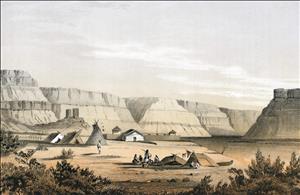On September 28, 1910, the flag at the U.S. military Fort Walla Walla is lowered and the fort is closed. The U.S. military had established Fort Walla Walla in 1856, during a war with the Walla Wallas. The fort had taken the name of the Hudson's Bay Fort Walla Walla, which had been abandoned in 1855 and then looted and burned. The town of Walla Walla had grown up around the fort, which had become a permanent military post and moved into expanded quarters by 1859. By the early twentieth century, the fort no longer has strategic significance for the area. The site will be used briefly during World War I, but in 1921 it will be converted into a veterans' hospital.
The Old Fort Walla Wallas
The first Fort Walla Walla was a Hudson’s Bay Company trading post. In 1818, at the confluence of the Walla Walla and Columbia rivers, the North West Company built Fort Nez Perces, which became a profitable center of trade in the region. The Hudson’s Bay Company absorbed the post in 1821, and it came to be known as Fort Walla Walla. The company abandoned the fort in 1855, after the area had become part of the United States, which by then was at war with local Native American tribes.
The name was next given to the temporary stockade that Lieutenant Colonel E. L. Steptoe (1816-1865) built in 1856, in what is today downtown Walla Walla, during the war with the Walla Wallas. The following year, Fort Walla Walla relocated to a permanent site southwest of its original site, where the future town of Walla Walla was taking form. One of the principal businesses of Walla Walla, which assumed this name in 1859, was supplying the fort.
The Fate of the Fort
Although Fort Walla Walla and Walla Walla were never attacked, from time to time during the nineteenth century troops were dispatched to engage in local conflicts. The fort was closed after the Civil War, but reopened in 1873. In 1903, Theodore Roosevelt (1858-1919) came to Walla Walla and praised those from the military who were present. But he also announced that the nation had entered a new industrial and international age.
Fort Walla Walla was finally closed on September 28, 1910. A band played “Auld Lange Syne,” the sunset gun was fired, and, as the band played “The Star Spangled Banner,” the flag over the fort was lowered for the last time. Present were two men who had seen the flag rise over the first U.S. Fort Walla Walla in 1856 and three who had seen it rise over the second in 1857. Whitman College attempted to obtain the land, but its efforts were challenged and the site remained abandoned, except for a brief period during World War I, until it was transferred to the Bureau of Public Health and converted to a veterans’ hospital in 1921.

